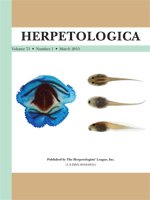In temperate zones, offspring born earlier in the breeding season might have more time to acquire resources before hibernation and consequently have higher survival rates. In this study, we tested the hypothesis that neonates born earlier in the birth season are smaller (in body size, mass, or both combined as body condition) than neonates born later, but that they have more time to acquire resources before hibernation. We used 43 laboratory-born litters of Thamnophis melanogaster and 21 litters of T. eques obtained from females collected from syntopic field sites. For both species, neonate body condition at birth differed within the birth season, such that sizes were smaller in the early portion, and larger in the later portion, of the season. When compared, only the snout–vent length and mass of neonates, averaged for each litter, did not change throughout the birth season. The temporal variation in neonate body condition found in the two species could explain increased offspring survival when neonates face challenging environmental conditions. If these differences reflect variations in the environment throughout the birth season, then body condition at birth could be relevant for neonate survival.
How to translate text using browser tools
1 March 2015
Timing of Birth and Body Condition in Neonates of Two Gartersnake Species from Central México
Javier Manjarrez,
Emma San-Roman-Apolonio
ACCESS THE FULL ARTICLE

Herpetologica
Vol. 71 • No. 1
March 2015
Vol. 71 • No. 1
March 2015
body size
condition
Sympatric snakes
Thamnophis eques
Thamnophis melanogaster




